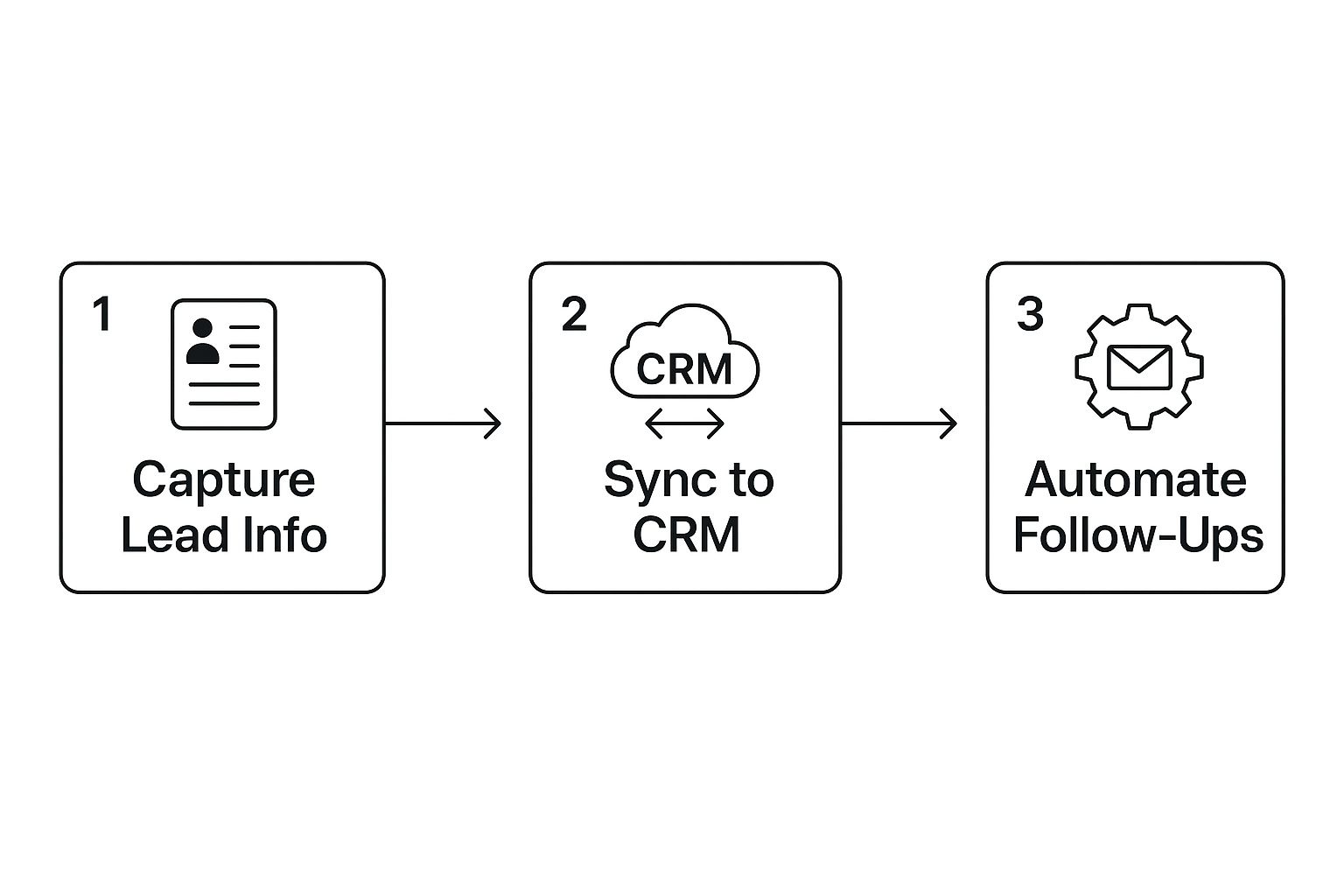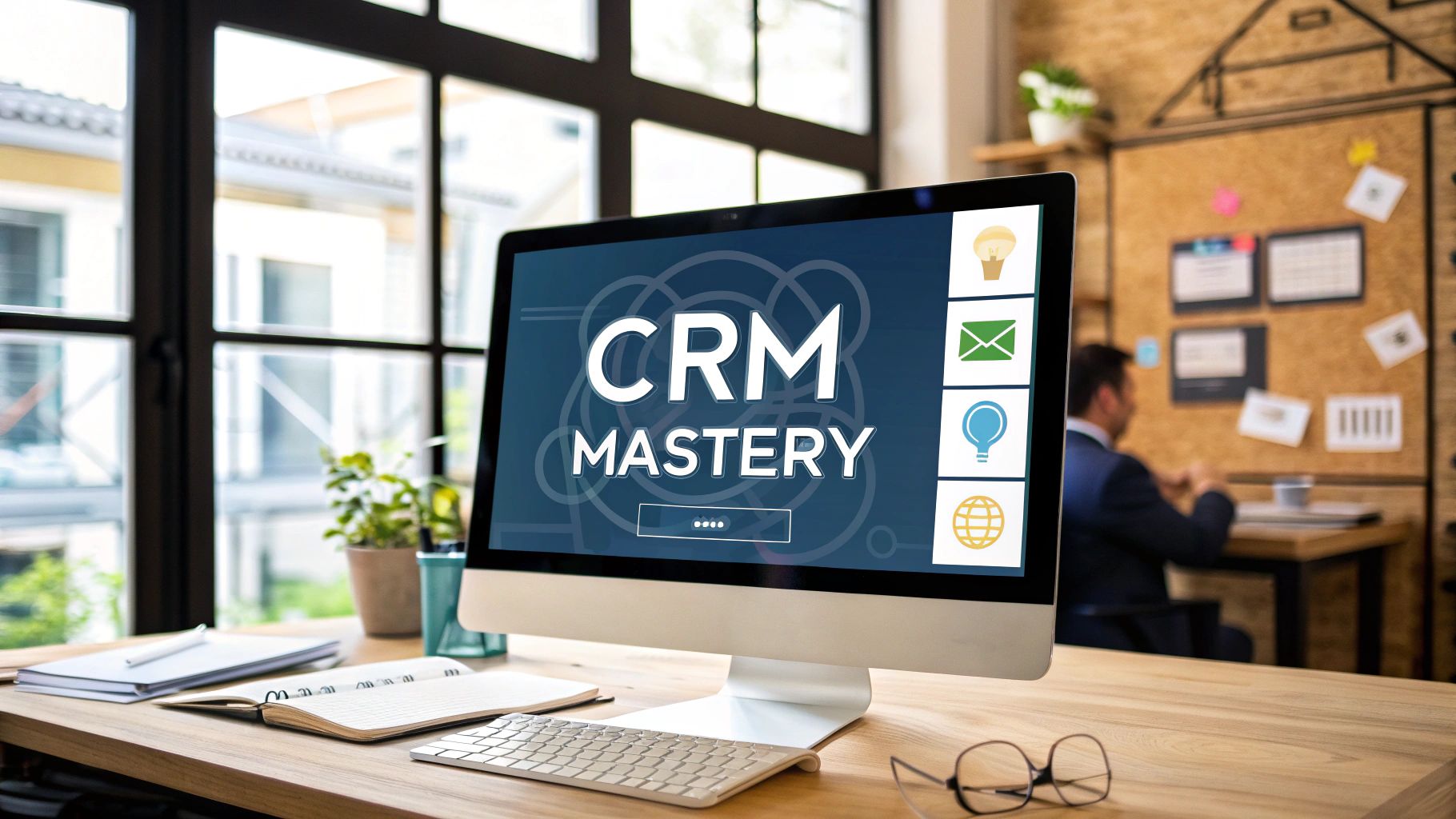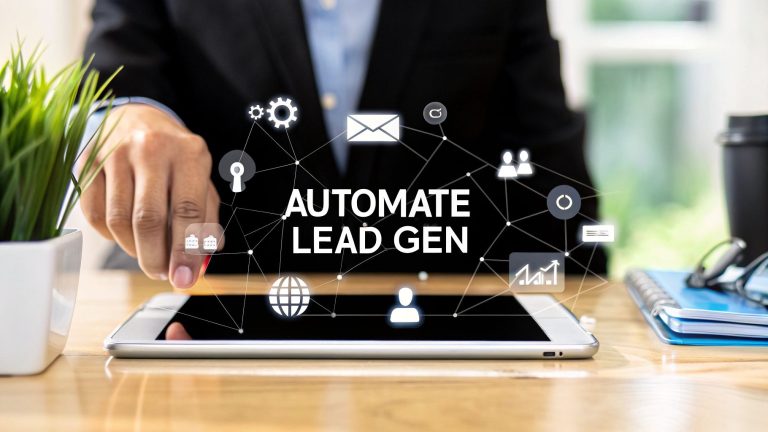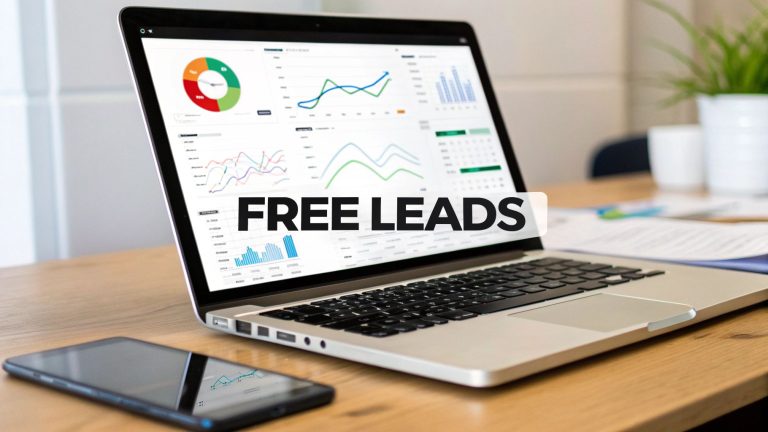CRM and Lead Generation Mastery: Proven Growth Strategies
Why CRM and Lead Generation Are Your Business Power Couple

Think of your business as a restaurant. Lead generation is like the enticing aroma of delicious food wafting onto the street, drawing hungry customers in. CRM (Customer Relationship Management), on the other hand, is the well-oiled machine inside – the host, servers, and kitchen working together to create a fantastic dining experience.
Without the enticing smells, the restaurant remains empty. Without the organized staff, even interested customers leave unhappy. This simple analogy shows how vital the relationship between CRM and lead generation is for any business.
The Power of Partnership
Just like a restaurant's front-of-house needs to know what the kitchen can offer, your lead generation needs to align with your CRM's capabilities. Promising personalized service while your CRM can't even track customer preferences is a recipe for disaster.
This interconnectedness is crucial for growth. Let's say a potential customer downloads a guide from your website. Your CRM system should capture this, tagging them as interested in that specific topic. This allows your marketing team to send targeted follow-up emails, guiding them towards a purchase.
From Scattered Chaos to Streamlined Success
Many businesses struggle with disorganized systems. Lead information gets lost in spreadsheets, follow-ups are sporadic, and opportunities are missed. It's like a restaurant where orders get mixed up, food comes out late, and no one seems to be in charge.
Integrating your CRM and lead generation creates a smooth, efficient process. Think of it as a digital concierge anticipating customer needs and providing personalized service at every step. This results in higher conversion rates, stronger customer relationships, and ultimately, more revenue.
The Growth Engine: CRM and Lead Generation’s Value
The CRM software market is experiencing significant growth. Valued at about $75.1 billion in 2023, it's projected to reach $248.2 billion by 2033, with a 12.7% CAGR. This growth reflects the increasing understanding of CRM's power across various industries. Learn more about CRM growth statistics here.
This investment isn't just about buying software. It's about creating a sustainable growth engine. By combining CRM and lead generation, businesses build a positive feedback loop: attracting the right leads, nurturing them effectively, and converting them into loyal customers who fuel further growth.
This partnership is essential for success in today's competitive market. It's about building relationships, not just collecting contacts. It's about understanding your customers and giving them value with every interaction. This is how you create a business that thrives.
How Smart CRM Systems Actually Capture Quality Leads

The infographic above shows the three steps involved in modern CRM and lead generation: capturing lead information, syncing it with your CRM, and automating follow-ups. This smooth integration is essential for efficient lead management. From the first point of contact to automated nurturing, each step builds on the previous one, creating a clear path from prospect to customer.
Remember the days of sticky notes and complicated spreadsheets? Modern CRM and lead generation tools are a world away from that. Imagine an always-on assistant capturing leads from your website, evaluating prospects based on their online behavior, and even predicting which leads need immediate attention. That’s the power of a smart CRM.
Understanding Lead Scoring Algorithms
Lead scoring algorithms are the secret ingredient to effective CRM and lead generation. Think of them as a points system for your potential customers. They assign values to leads based on things like website activity, demographics, and engagement.
For example, someone downloading several resources and frequently visiting pricing pages gets a higher score than someone who simply subscribes to your blog. This helps you prioritize leads and focus your energy where it matters most. Your sales team can then concentrate on the hottest prospects, while automated workflows nurture leads who are still exploring. This targeted approach makes everyone more efficient.
The Magic of Progressive Profiling
Progressive profiling is like a detective piecing together a case. Instead of overwhelming potential customers with long forms, it gathers information gradually. Each interaction reveals a little more, creating a progressively richer profile without being intrusive.
For example, after a prospect downloads a whitepaper, the next form might ask about their company size. Later on, you might inquire about their budget or specific needs. This targeted approach gathers valuable information while respecting the prospect’s time.
Automating Workflows for Efficiency
Automation workflows are like setting up a chain reaction. One action triggers the next, nurturing leads automatically. This lets you scale your lead generation efforts without a massive team.
Imagine sending personalized emails, adding leads to targeted campaigns, or notifying sales reps—all triggered by specific lead actions. While you’re closing deals, your CRM is busy nurturing hundreds of leads simultaneously. This allows you to significantly boost overall sales performance and contribute to a more robust sales pipeline, ultimately increasing revenue.
Let's explore how traditional lead qualification stacks up against a CRM-powered approach. The following table highlights the key differences.
Lead Qualification Methods Comparison
| Method | Time Required | Accuracy Rate | Scalability | Cost Efficiency |
|---|---|---|---|---|
| Traditional (Manual) | High (lots of manual effort) | Low (prone to human error) | Limited (difficult to scale) | Low (labor intensive) |
| CRM-Automated | Low (automated processes) | High (data-driven insights) | High (easily adaptable to growth) | High (reduces labor costs) |
As you can see, CRM automation offers significant advantages in terms of speed, accuracy, scalability, and cost-effectiveness compared to traditional methods. This allows businesses to optimize their lead qualification process and focus on converting high-potential leads.
Integration Strategies That Transform Lead Generation
This screenshot gives you a peek behind the curtain of the Facebook Marketing API for lead ads. It shows how developers can access and manage the data you collect. Essentially, it's the technical bridge that lets Facebook talk directly to your CRM. This means lead info captured on Facebook flows automatically into your CRM, saving you from manual data entry and speeding up response times.
Think of integrations between your CRM and lead generation tools like building bridges between islands. Each island is a vital part of your sales process: your website, email marketing platform, social media, and, of course, your CRM. Without those bridges, valuable leads get stranded, and your team wastes time paddling back and forth with information.
Streamlining the Lead Journey with Integrations
The point of integrating your CRM and lead generation efforts isn’t to connect everything just for the sake of it. It's about creating a smooth, efficient path for your leads. A prime example is linking Facebook Lead Ads directly to your CRM. This allows for near-instantaneous lead capture and follow-up.
Imagine: a lead fills out a form on Facebook and gets a personalized email from your sales team minutes later. This speed and efficiency can dramatically boost your conversion rates. Want to learn more? Check out our guide on CRM integration with Facebook.
The Power of Email Marketing Integration
Another essential integration strategy connects your email marketing platform and your CRM. This lets you trigger personalized email sequences based on data in your CRM. For example, if a lead downloads a particular resource, your CRM can automatically tag them with that interest and trigger a targeted email series with more information. This automated nurturing keeps leads engaged without constant manual effort.
Website Tracking: Uncovering the Complete Story
Integrating website tracking into your CRM and lead generation strategy is like having x-ray vision into your sales process. You see exactly how prospects interact with your website—which pages they visit, how long they stay.
This data reveals the entire customer journey, not just isolated snapshots. You understand what content resonates, optimize your website for conversions, and personalize the lead experience based on individual behavior.
These insights are gold for refining your marketing strategies and improving your overall ROI. By understanding the customer's digital body language, you can anticipate their needs and offer the right solutions at the perfect moment. This transforms your website from a static brochure into a dynamic lead generation machine.
The AI Evolution in CRM Lead Generation
Imagine having a tireless sales assistant who can sift through mountains of data, predict which leads are most likely to buy, and even craft the perfect message for each individual. That's the power of Artificial Intelligence (AI) in Customer Relationship Management (CRM). It's not some futuristic fantasy—it's happening right now.
Predictive Analytics: Finding the Gold Nuggets
AI-powered CRMs are transforming lead generation with predictive analytics. Think of it like a prospector panning for gold. AI can analyze thousands of data points—website visits, email opens, social media interactions—to identify which leads are genuinely interested and which are just window shopping.
For example, AI might notice that a lead who has visited your pricing page multiple times and downloaded a product brochure is likely ready for a sales call, even if they haven't filled out a contact form. This allows your team to focus on the hottest leads, dramatically boosting efficiency and sales.
Automated Lead Scoring: A System That Learns and Grows
Traditional lead scoring is often static and inflexible. AI changes the game with dynamic, self-learning algorithms. Your lead scoring system becomes smarter over time, like a student who learns from their mistakes. As your CRM gathers more data, the AI analyzes past interactions to refine its scoring model.
This is invaluable in complex sales cycles where the journey to conversion isn't always straightforward. AI can spot subtle changes in lead behavior, indicating a shift in buying intent. This allows sales teams to adapt their approach, providing the right information at the perfect moment.
Personalized Content: The Right Message, Every Time
AI enables true personalization at scale. Imagine sending tailored content to hundreds of leads, each message perfectly aligned with their interests. This is the potential of AI-driven CRM and lead generation.
AI can even suggest the best content for each lead based on their past activity, ensuring every interaction adds value and builds trust. By leveraging AI in their CRM, businesses are seeing tangible results. For instance, repeat sales and customer retention can increase by 15%.
AI-Powered Tools: Chatbots and Beyond
AI's impact on CRM goes beyond analytics and scoring. AI-powered Chatbots can qualify leads in real-time, offering 24/7 support and gathering valuable information. These chatbots handle routine inquiries, freeing up your team to focus on more complex tasks.
AI can also create personalized email sequences that adapt based on how a prospect interacts with your messages. If a lead opens a specific email, the system can automatically send a follow-up with related content. This automation helps nurture leads effectively without constant manual intervention. Tools like this are revolutionizing how businesses interact with potential customers, creating a more efficient and personalized experience. The growth of the AI in CRM market underscores this trend. Projected to reach $11.04 billion by 2025, it's estimated to climb to $48.4 billion by 2033. For more on the impact of these technologies, explore these lead generation statistics. With 80% of salespeople anticipating the use of AI to maximize their CRM's value in the next five years, the future of sales is clearly intertwined with the power of AI.
Essential Metrics That Reveal Lead Generation Health

While knowing your lead volume and conversion rates is important, it's a bit like knowing how much gas is in your car. Sure, it's useful, but it doesn't tell you if the engine's about to blow a gasket. To really understand how well your CRM and lead generation are working together, you need to look under the hood.
Beyond the Basics: Key Metrics for Lead Generation Health
Just as a doctor relies on vital signs to get a clear picture of a patient's health, you need a core set of metrics to diagnose the health of your lead generation system. These metrics will provide a much deeper understanding of how your pipeline is performing and give you a glimpse into future opportunities.
-
Lead Velocity Rate (LVR): This metric tracks the growth rate of qualified leads coming into your sales pipeline. A steadily increasing LVR is a great indicator of a healthy lead generation system. Imagine your LVR is 10%. That means your pool of qualified leads is growing by 10% every month.
-
Customer Lifetime Value (CLTV): CLTV helps you predict how much revenue a single customer will generate throughout their relationship with your business. This is incredibly valuable for deciding how much you should invest in acquiring new customers. A higher CLTV means you can justify spending a bit more to get them on board.
-
Lead Conversion Rate: This is the percentage of your leads that actually convert into paying customers. Tracking this metric will give you a good idea of how effective your nurturing campaigns and sales process are. If your conversion rate is low, it might signal problems within your sales funnel or suggest that your leads aren't as qualified as you think they are.
-
Time to Conversion: This metric measures how long it takes for a lead to become a customer. A shorter conversion time means a more efficient sales process. If you analyze this closely, you might uncover bottlenecks in your lead nurturing workflows.
Building Dashboards That Drive Action
A good dashboard isn't just a collection of pretty charts. It's a tool that gives you actionable insights. Think of your CRM dashboard as the cockpit of an airplane – it provides all the critical information you need to navigate successfully.
-
Focus on Key Metrics: Don't overwhelm yourself by tracking every single metric under the sun. Choose the ones that truly align with your business goals and monitor them consistently.
-
Visualize Trends: Charts and graphs are your friends. They make it much easier to spot trends over time and identify patterns.
-
Set Benchmarks: Compare your performance against industry averages to get a sense of where you stand. This can help you pinpoint areas for improvement and set achievable goals.
-
Early Warning Indicators: Keep a close eye out for sudden dips in LVR or conversion rates. These can be early warning signs of declining lead quality or issues within your sales funnel. Want to explore how to streamline this process? Dive into our guide on how to automate lead generation.
By concentrating on these key metrics and creating dashboards that actually give you useful information, you can transform data overload into strategic clarity. This will allow you to optimize your CRM and lead generation efforts for maximum efficiency and sustainable growth.
To help you track and understand these vital metrics, let's take a look at the following table:
Key CRM Lead Generation Metrics
Essential KPIs and their benchmarks for measuring CRM lead generation success
| Metric | Definition | Industry Benchmark | Calculation Method | Action Threshold |
|---|---|---|---|---|
| Lead Velocity Rate (LVR) | Percentage increase in qualified leads month-over-month | 10-20% | ((Current Month Qualified Leads – Previous Month Qualified Leads) / Previous Month Qualified Leads) * 100 | <5% |
| Customer Lifetime Value (CLTV) | Predicted total revenue generated by a customer | Varies greatly by industry | Average Purchase Value * Average Purchase Frequency * Average Customer Lifespan | Below industry average |
| Lead Conversion Rate | Percentage of leads that become customers | 2-5% (B2B), 5-10% (B2C) | (Number of Customers / Number of Leads) * 100 | Below 2% (B2B), Below 5% (B2C) |
| Time to Conversion | Time taken for a lead to become a customer | Varies by industry and sales cycle | Date of Customer Conversion – Date of Lead Acquisition | Significantly longer than average sales cycle |
This table summarizes the key metrics discussed and provides industry benchmarks, calculation methods, and action thresholds. Keeping a close eye on these numbers and taking action when they fall below the threshold can help you keep your lead generation engine running smoothly. By consistently monitoring and analyzing these key metrics, you can identify areas for improvement, optimize your strategies, and ultimately drive more revenue for your business.
Advanced Workflows That Scale Lead Generation Success
The most successful businesses don't just collect leads; they nurture them. They build sophisticated nurturing campaigns within their CRM and lead generation systems. These campaigns feel personal and arrive at precisely the right time.
These advanced workflow strategies automatically adapt based on a few key factors: lead behavior, industry changes, company specifics, and how leads interact with your content. Doing this manually would be a logistical nightmare.
Crafting Multi-Touch Campaigns That Convert
Imagine a multi-touch campaign as a well-planned dance. Each step flows into the next, guiding your prospect through the buying journey. The key is to make each interaction valuable and relevant, creating a helpful dialogue, not a sales monologue. You might find this helpful: Facebook Lead Management Simplified.
Let's say someone downloads a social media marketing guide from your website. Your CRM, using a pre-set workflow, tags them as interested in social media. Then, it triggers a series of emails with more in-depth resources. If they click a link about Instagram marketing in one of those emails, the CRM automatically puts them into a new, Instagram-focused workflow. It's a dynamic, responsive system that feels tailored to each individual.
The Psychology of Effective Lead Nurturing
Effective lead nurturing isn't about bombarding people with emails; it's about understanding their motivations. It’s a careful blend of valuable content and strategically placed sales messages.
A powerful tactic is to focus your content on solving the prospect's problems. Instead of listing product features, explain how your product eases their pain points. For example, if you sell project management software, focus your emails on the common frustrations of disorganized teams and how your software simplifies collaboration.
Segmentation: Going Beyond Basic Demographics
Segmentation involves grouping leads based on shared traits, letting you create highly targeted campaigns. Basic demographics like age and location are a good start, but advanced segmentation goes much deeper.
Think about behavioral triggers. Did someone abandon their online shopping cart? Trigger a workflow with a discount or reminder of your product's benefits. Have they visited a specific product page several times? Send a personalized email with more information about that product. These targeted touches dramatically improve engagement and conversion rates.
Lead generation stats show that companies are using more digital tools to find new customers and improve their marketing results. Combining CRM and advanced lead generation helps businesses optimize campaigns, improve customer connections, and boost conversions. Discover more insights here. These strategies help your lead generation system become smarter and more effective, turning prospects into loyal customers.
Your CRM Lead Generation Action Plan
Having explored the theory and best practices of lead generation, let's talk about putting them into action. This isn't about abstract concepts; it's about a practical roadmap you can use right now, no matter the size of your team. We'll cover how to audit your current setup, find quick wins, and map out long-term improvements.
Auditing Your Current Lead Generation System
Before making any changes, you need to understand where you stand. Think of it like a mechanic checking your car's engine before tuning it up. A thorough assessment reveals both the strong points and the areas needing attention, giving you a baseline to measure your progress. Ask yourself these key questions:
- What are the sources of your leads? (Website forms, social media, referrals, etc.)
- Which tools are you currently using for lead capture and management?
- How quickly are you following up with a new lead?
- What’s your current lead conversion rate?
This initial audit paints a clear picture of your existing CRM and lead generation processes, highlighting areas for immediate improvement and laying the foundation for your action plan.
Identifying Quick Wins for Immediate Results
Once you understand your current situation, focus on achievable improvements that deliver rapid results. These quick wins build momentum and demonstrate the value of your efforts. Think of them as low-hanging fruit – easy to grab and enjoy. Here are a few examples:
- Automate lead capture: Tools like LeadSavvy Pro automatically capture leads from Facebook Lead Ads, doing away with manual downloads and ensuring no leads slip through the cracks.
- Improve response times: Set up automated email responses to acknowledge new leads and offer valuable information while they're still hot.
- Streamline lead qualification: Use lead scoring to prioritize high-potential leads, so your sales team focuses its energy where it matters most. Think of it like a triage system in a hospital – focusing on the most urgent cases first.
These quick wins showcase the impact of optimized CRM and lead generation strategies, providing concrete results that encourage further improvement.
Planning Long-Term Improvements
While quick wins offer immediate benefits, sustainable growth requires a long-term vision. It's like building a house – you need a solid blueprint before you start laying bricks. This means prioritizing upgrades based on your specific business needs and growth objectives. Consider these strategic steps:
- CRM platform evaluation: Research different CRM platforms and choose one that fits your long-term goals, considering factors like scalability, integration capabilities, and reporting features.
- Implementation strategy: Create a phased implementation plan to minimize disruption and ensure a smooth transition. Think of it like changing lanes on a highway – you need to signal and check your blind spot before making the move.
- Change management: Prepare your team for the changes by providing thorough training and emphasizing the benefits of the new processes. This will help alleviate any resistance and get everyone on board.
This long-term vision helps you stay ahead of the curve in CRM and lead generation, ensuring your system adapts to changing market conditions.
By combining a clear audit of your current system with a focus on both short-term gains and long-term strategy, you can create a powerful and adaptable action plan for maximizing your CRM and lead generation success. Ready to simplify your Facebook lead capture and unlock the full potential of your campaigns? Explore LeadSavvy Pro today and see how easy it is to automate your lead management, nurture prospects effectively, and convert high-quality leads into loyal customers.







